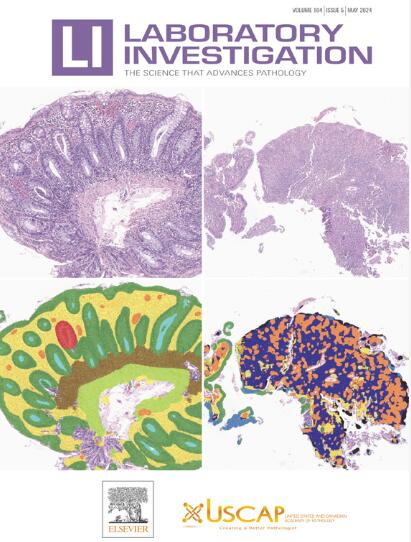Epigenomic and Transcriptomic Profiling of Solitary Fibrous Tumors Identifies Site-Specific Patterns and Candidate Genes Regulated by DNA Methylation
IF 4.2
2区 医学
Q1 MEDICINE, RESEARCH & EXPERIMENTAL
引用次数: 0
Abstract
A solitary fibrous tumor (SFT) is a rare mesenchymal neoplasm that can arise at any anatomical site and is characterized by recurrent NAB2::STAT6 fusions and metastatic progression in 10% to 30%. The cell of origin has not been identified. Despite some progress in understanding the contribution of heterogeneous fusion types and secondary mutations to SFT biology, epigenetic alterations in extrameningeal SFT remain largely unexplored, and most sarcoma research to date has focused on the use of methylation profiling for tumor classification. We interrogated genome-wide DNA methylation in 79 SFTs to identify informative epigenetic changes. RNA-seq data from targeted panels and data from the Cancer Genome Atlas (TCGA) were used for orthogonal validation of selected findings. In unsupervised clustering analysis, the top 500 most variable cytosine-guanine sites segregated SFTs by primary anatomical site. Differentially methylated genes associated with the primary SFT site included EGFR; TBX15; multiple HOX genes; and their cofactors EBF1, EBF3, and PBX1; as well as RUNX1 and MEIS1. Of the 20 DMGs interrogated on the RNA-seq panel, 12 were significantly differentially expressed according to site. However, except TBX15, most of these also showed differential expression according to NAB2::STAT6 fusion type, suggesting that the fusion oncogene contributes to the transcriptional regulation of these genes. Transcriptomic data confirmed an inverse correlation between gene methylation and the expression of TBX15 in both SFT and TCGA sarcomas. TBX15 also showed differential mRNA expression and 5′ UTR methylation between tumors in different anatomical sites in TCGA data. In all analyses, TBX15 methylation and mRNA expression retained the strongest association with tissue of origin in SFT and other sarcomas, suggesting a possible marker to distinguish metastatic tumors from new primaries without genomic profiling. Epigenetic signatures may further help to identify SFT progenitor cells at different anatomical sites.
单发纤维性肿瘤的表观基因组和转录组分析确定了受DNA甲基化调控的特定位点模式和候选基因。
孤立性纤维瘤(SFT)是一种罕见的间叶肿瘤,可发生于任何解剖部位,其特点是复发性 NAB2::STAT6 融合,10%-30% 的肿瘤会发生转移。其起源细胞尚未确定。尽管在了解异质融合类型和继发性突变对 SFT 生物学的贡献方面取得了一些进展,但脑膜外 SFT 的表观遗传学改变在很大程度上仍未得到探索,迄今为止,大多数肉瘤研究都集中在使用甲基化分析进行肿瘤分类。我们对 79 例 SFT 的全基因组 DNA 甲基化进行了研究,以确定有参考价值的表观遗传学变化。来自靶向研究小组的RNA-seq数据和来自癌症基因组图谱(TCGA)的数据被用于对所选研究结果进行正交验证。在无监督聚类分析中,前 500 个变化最大的 CpGs 按主要解剖部位分离出 SFT。与原发SFT部位相关的差异甲基化基因(DMGs)包括表皮生长因子受体、TBX15、多个HOX基因及其辅助因子EBF1、EBF3和PBX1,以及RUNX1和MEIS1。在RNA-seq面板上检测的20个DMGs中,有12个在不同位点有显著差异表达。然而,除了 TBX15 外,其中大多数也根据 NAB2::STAT6 融合类型显示出差异表达,这表明融合癌基因有助于这些基因的转录调控。转录组数据证实,在 SFT 和 TCGA 肉瘤中,基因甲基化与 TBX15 的表达呈反相关。在 TCGA 数据中,位于不同解剖部位的肿瘤之间,TBX15 的 mRNA 表达和 5' UTR 甲基化也存在差异。在所有分析中,TBX15 的甲基化和 mRNA 表达与 SFT 和其他肉瘤的原发组织的关联性最强,这表明在没有基因组图谱分析的情况下,TBX15 可能是区分转移性肿瘤和新原发肿瘤的标记物。表观遗传特征可进一步帮助识别不同解剖部位的SFT祖细胞。
本文章由计算机程序翻译,如有差异,请以英文原文为准。
求助全文
约1分钟内获得全文
求助全文
来源期刊

Laboratory Investigation
医学-病理学
CiteScore
8.30
自引率
0.00%
发文量
125
审稿时长
2 months
期刊介绍:
Laboratory Investigation is an international journal owned by the United States and Canadian Academy of Pathology. Laboratory Investigation offers prompt publication of high-quality original research in all biomedical disciplines relating to the understanding of human disease and the application of new methods to the diagnosis of disease. Both human and experimental studies are welcome.
 求助内容:
求助内容: 应助结果提醒方式:
应助结果提醒方式:


